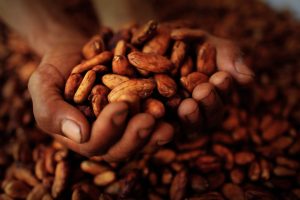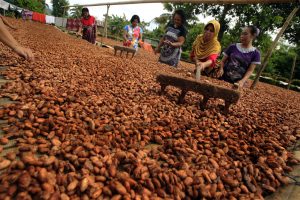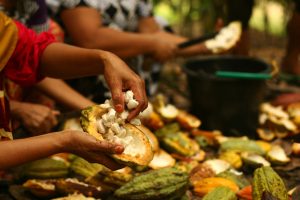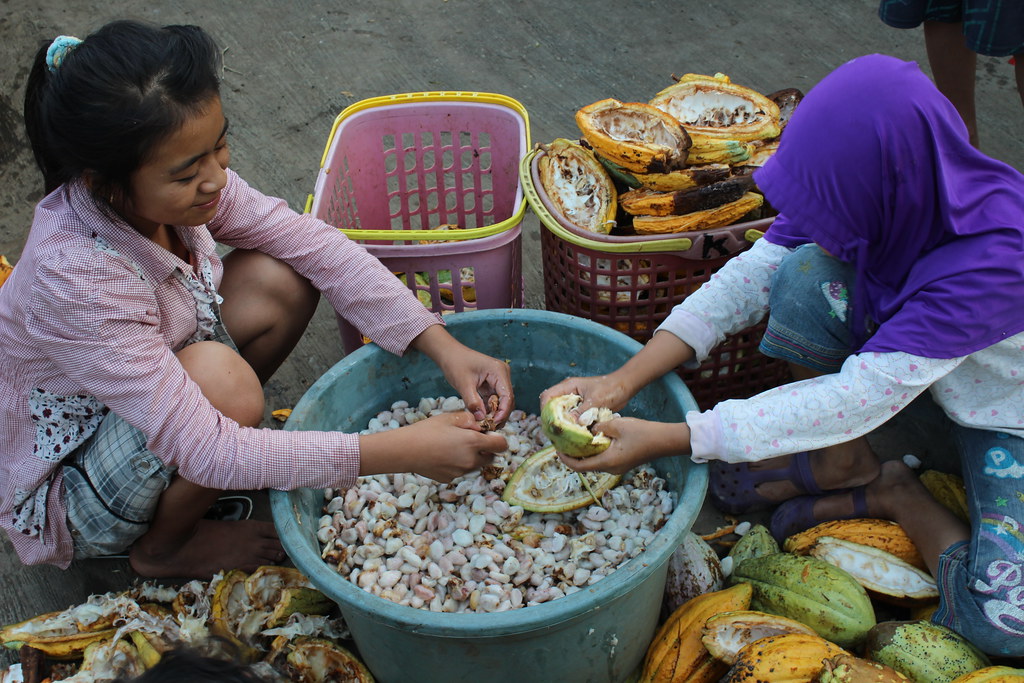Cocoa cultivation is of utmost importance to the chocolate industry, serving as the primary source of raw material for this beloved treat. Understanding the influence of altitude on cocoa cultivation is crucial for ensuring the sustainability and quality of cocoa production. Altitude can impact various aspects of cocoa farming, including flavor, disease resistance, and yield. By delving deeper into these factors, farmers and researchers can implement appropriate techniques and adaptation strategies to overcome challenges and secure the future of cocoa production.
Altitude plays a significant role in cocoa cultivation.The optimal range for cocoa growth typically falls between 200 and 800 meters above sea level. At higher altitudes, cocoa trees experience lower temperatures and increased exposure to sunlight, resulting in slower fermentation and the development of distinct flavors in the cocoa beans. Higher altitudes also contribute to higher acidity in cocoa, further influencing the flavor profile.
For instance, in the high-altitude regions of Ecuador, cocoa beans are renowned for their unique fruity and floral flavors. The cooler temperatures and extended fermentation process at higher altitudes contribute to the development of these distinct flavor characteristics. Consequently, Ecuadorian cocoa is highly sought after by chocolate manufacturers and connoisseurs worldwide.
Additionally, altitude can also impact disease resistance in cocoa trees.Some diseases, such as frosty pod rot, thrive at higher altitudes, posing a significant threat to cocoa production. However, cocoa trees grown at higher altitudes often exhibit increased disease resistance, which can be advantageous for farmers. This natural resilience helps mitigate the impact of diseases and reduces the need for chemical interventions, promoting more sustainable farming practices.
Factors Affecting Cocoa Cultivation at Different Altitudes



Growing cocoa at different altitudes presents both challenges and benefits. One of the challenges is increased vulnerability to pests and diseases. Higher altitudes provide a more favorable environment for pests such as cocoa mirids and diseases like frosty pod rot, which can significantly impact cocoa yield and quality. However, there are also benefits to growing cocoa at different altitudes. Slower fermentation at higher altitudes can enhance the aroma of cocoa beans, creating unique flavors highly appreciated by chocolate connoisseurs. Furthermore, cocoa trees grown at higher altitudes tend to exhibit increased disease resistance, which can be advantageous for farmers.
Climate and environmental factors play a crucial role in cocoa cultivation at different altitudes. Temperature, rainfall, and humidity levels vary with altitude and significantly influence the success of cocoa farming. Understanding and managing these factors are essential for optimizing cocoa production at different altitudes.
For example, in the lowland regions of Ghana, where cocoa is traditionally grown, high humidity and rainfall create an ideal environment for cocoa cultivation. The consistent warm temperature promotes rapid fermentation, resulting in a flavor profile characterized by rich, earthy notes. On the other hand, in the mountainous regions of Peru, where cocoa is grown at higher altitudes, lower temperatures and less rainfall create a different flavor profile. The slower fermentation process at these altitudes leads to cocoa beans with a more delicate and complex flavor, often described as fruity and floral.
By comprehending the specific climate and environmental conditions at different altitudes, farmers can adapt their cultivation practices to optimize cocoa production and achieve desired flavor profiles. This knowledge also allows researchers to develop targeted strategies to overcome challenges and improve cocoa farming techniques at different altitudes.
Research Source 1 highlights the importance of selectively bred drought-resistant cocoa seeds and the traditional “cabruca” cultivation method in adapting to climate change. These strategies can help cocoa growers cope with the changing climate conditions and sustain cocoa production. The “cabruca” method involves retaining or replanting other rainforest trees to provide shade and decrease temperature and evapotranspiration. It also helps store carbon and preserve natural habitats, contributing to sustainable cocoa farming practices.
Research Source 3 further emphasizes the challenges faced by cocoa farmers at different altitudes due to climate change. Increased pests, diseases, and temperature variations can decrease cocoa yields, affecting the livelihoods of farmers. The study also highlights the importance of adapting to climate change through early planting, intercropping, mulching, and the use of drought-resistant varieties. Socioeconomic factors such as gender, age, education, and farming experience influence the adaptation measures implemented by cocoa farmers.
Climate Change and Its Impact on Cocoa Production
Climate change poses significant challenges to cocoa production, including the influence of altitude. Rising temperatures and reduced humidity levels can have detrimental effects on cocoa trees, affecting their growth and productivity. As a result, cocoa cultivation areas are expected to shift uphill by 2050 to compensate for changing climate conditions.These changes threaten the availability of land for cocoa cultivation and pose a risk to food security and the livelihoods of farmers, particularly in West African countries.
To mitigate the impact of climate change, adaptation strategies are essential. Selective breeding of drought-resistant cocoa seeds is one approach that can improve the resilience of cocoa trees to changing climate conditions. Another method is the “cabruca” cultivation method, which involves retaining or replanting rainforest trees to provide shade and regulate temperature, decreasing the vulnerability of cocoa trees to extreme weather events. These strategies, along with others, are necessary to ensure the continued production of cocoa in the face of climate change.
For example, in the Ivory Coast, which is the world’s largest cocoa producer, cocoa farmers are already experiencing the effects of climate change. Increasingly unpredictable rainfall patterns and extended dry seasons have led to reduced cocoa yields. To address this, research institutions and organizations have introduced drought-resistant cocoa varieties that can withstand the changing climate conditions. These varieties have shown promising results in maintaining cocoa productivity and ensuring the livelihoods of thousands of cocoa farmers.
Efforts are also being made to implement climate adaptation and mitigation measures. Research Source 2 highlights the costly nature of these initiatives and the need for increased investments to tackle the impact of climate change on cocoa production. Financing for adaptation efforts in cocoa-producing countries must triple by 2030 and quadruple by 2050, amounting to a total of $8.1 trillion over time. Private sector capital and support from non-profit organizations can play a significant role in alleviating the financial burden on cocoa farmers and facilitating the implementation of these necessary measures.
By investing in adaptation measures and implementing sustainable farming practices, cocoa farmers can mitigate the effects of climate change and continue to produce high-quality cocoa. This not only secures the future of cocoa farming but also ensures a steady supply of chocolate for consumers worldwide.
Research Source 4 emphasizes the need for collaboration between researchers, farmers, and organizations to improve cocoa farming.Training programs and integrated pest-management techniques are being used to enhance productivity and quality in cocoa farming. Through collaborative efforts, innovative techniques such as novel planting, irrigation, and pest-management methods are being developed to address the challenges faced by cocoa farmers. Additionally, the cacao genome has been sequenced and analyzed, aiding in the breeding of hardier trees with improved resilience to pests, diseases, and climate change.
The future of chocolate relies on innovative, energetic coalitions working to make cocoa a sustainable crop. With increasing consumer demand for chocolate, the need for sustainable cocoa production is more significant than ever. Ongoing research on selective breeding and farmer education efforts continues to improve cocoa tree resilience and enhance the productivity and quality of cocoa farming.
In conclusion, altitude plays a crucial role in cocoa cultivation, influencing flavor, disease resistance, and yield. Higher altitudes contribute to distinct flavors and increased acidity in cocoa, making it highly sought after by chocolate connoisseurs. While growing cocoa at different altitudes presents challenges such as increased vulnerability to pests and diseases, it also offers benefits, including slower fermentation and enhanced aroma. Understanding the influence of altitude on cocoa farming is essential for implementing appropriate techniques and adaptation strategies. Climate change poses significant challenges to cocoa production, necessitating the adoption of adaptation measures such as selective breeding and the “cabruca” cultivation method. Collaboration between stakeholders, increased investments, and the development of innovative techniques are key to ensuring the future of sustainable cocoa production.

